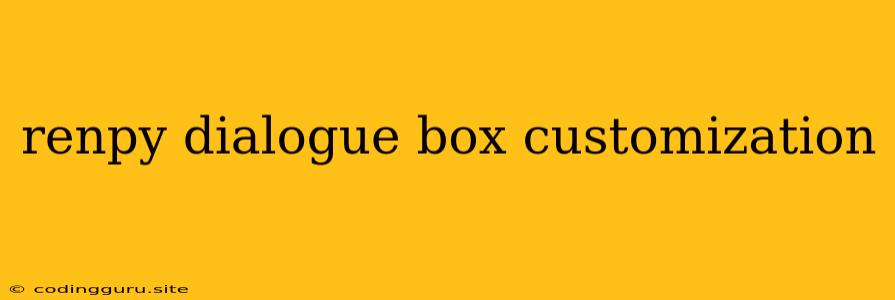Ren'Py Dialogue Box Customization: Enhancing Your Visual Novel Experience
Ren'Py, the powerful visual novel engine, allows you to craft immersive and engaging stories. One crucial aspect of this immersive experience is the dialogue box, which displays the characters' words and often sets the tone for the scene. While Ren'Py provides a default dialogue box, customizing it can greatly enhance the visual appeal and storytelling potential of your game.
This article explores various techniques for customizing the dialogue box in Ren'Py, helping you create a unique and visually captivating experience for your players.
Understanding the Ren'Py Dialogue Box Structure
Before diving into customization, it's essential to understand the basic structure of a Ren'Py dialogue box. It consists of several key elements:
- Background: The base image or color behind the text.
- Text: The actual dialogue displayed.
- Namebox: The area displaying the character's name.
- Character Image: The portrait of the character speaking.
- Window: The entire dialogue box frame.
Customizing the Dialogue Box: A Comprehensive Guide
Ren'Py provides flexibility in customizing each of these elements. Here are some powerful techniques:
1. Changing the Background:
- Using Image Files: You can replace the default background with a custom image. Simply define the image in your script and use it as the "background" property in the "style" section:
style default dialogue:
background "my_custom_background.png"
- Solid Colors: If you want a solid color background, use the "color" property instead:
style default dialogue:
background "#ffffff"
2. Tweaking the Text Style:
- Font: Change the font used for the dialogue text:
style default dialogue:
font "my_custom_font.ttf"
- Font Size: Adjust the text size:
style default dialogue:
size 24
- Color: Change the text color:
style default dialogue:
color "#000000"
- Alignment: Align the text (left, center, right):
style default dialogue:
text_align 1
3. Enhancing the Namebox:
- Font: Customize the font used for the character's name:
style default namebox:
font "my_namebox_font.ttf"
- Color: Change the namebox text color:
style default namebox:
color "#ffff00"
- Position: Adjust the position of the namebox relative to the text:
style default namebox:
xpos 100
ypos 10
4. Managing the Character Image:
- Image Placement: You can place the character image above, below, or next to the dialogue text. Adjust the
xposandyposvalues accordingly:
style default dialogue:
xpos 100
ypos 100
- Image Scaling: Control the size of the character image:
style default dialogue:
image_scale 0.5
5. Transforming the Entire Window:
- Border: Add a border to the dialogue box:
style default dialogue:
border_thickness 2
border_color "#000000"
- Rounded Corners: Create rounded corners for a softer look:
style default dialogue:
corner_radius 10
- Opacity: Adjust the transparency of the dialogue box:
style default dialogue:
alpha 0.8
Implementing Custom Dialogue Styles
Once you've created a custom dialogue style, apply it to specific characters or situations within your script using the style keyword:
say "I love customizing Ren'Py dialogue boxes!" style "my_custom_style"
Advanced Dialogue Box Customization:
For more advanced customization, consider these techniques:
- Dynamic Styles: Use Python code to dynamically change the dialogue box based on factors like character emotions or game progress.
- Animations: Add visual effects like fades, zooms, or transitions to the dialogue box for added dynamism.
- User Interface (UI) Libraries: Utilize UI libraries for more intricate customization and control over the dialogue box elements.
Conclusion:
Customizing the dialogue box in Ren'Py is an essential step towards crafting a visually stunning and engaging visual novel. By leveraging the various techniques discussed above, you can personalize the look and feel of your dialogue, creating a more immersive and memorable experience for your players.
